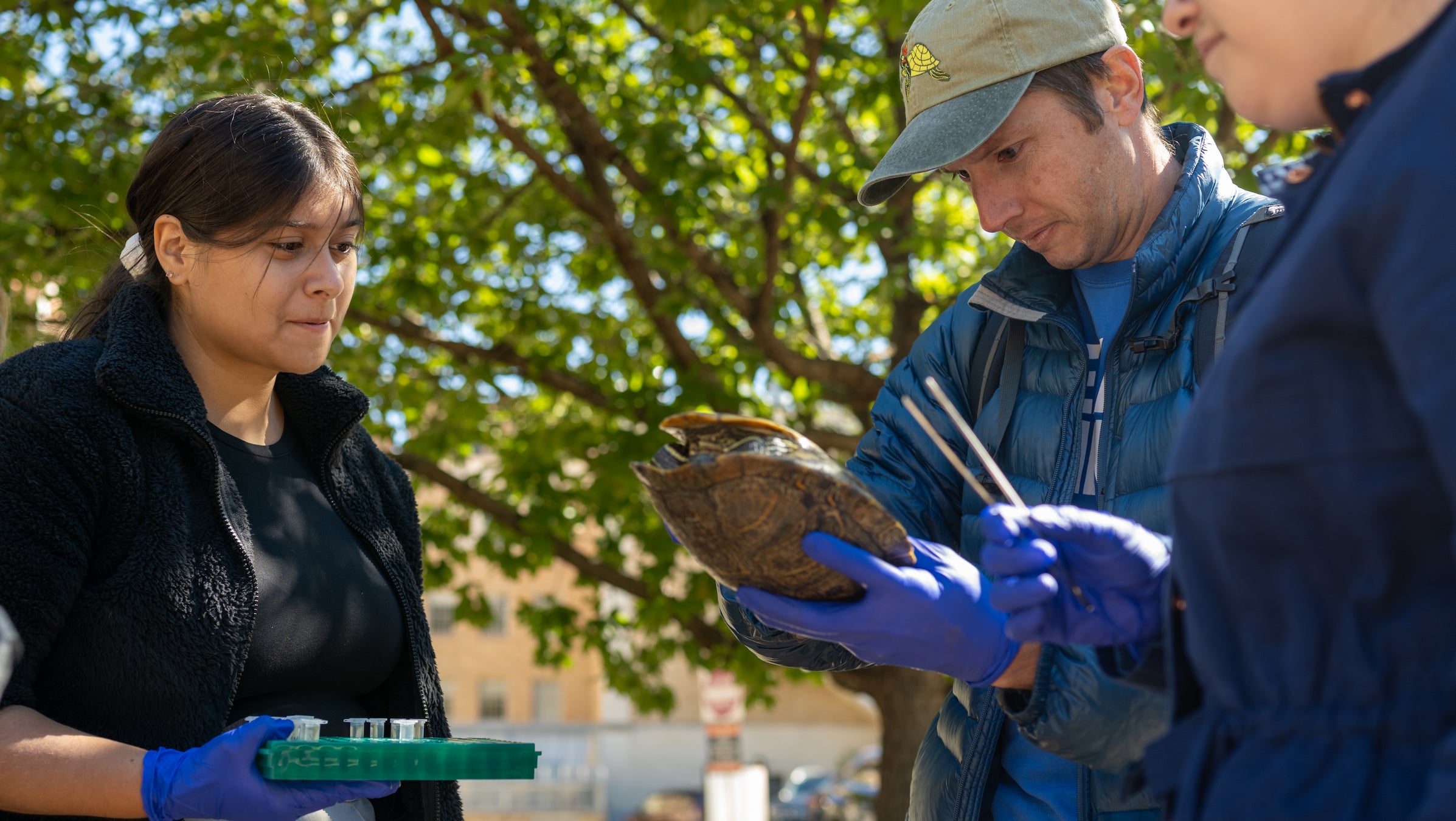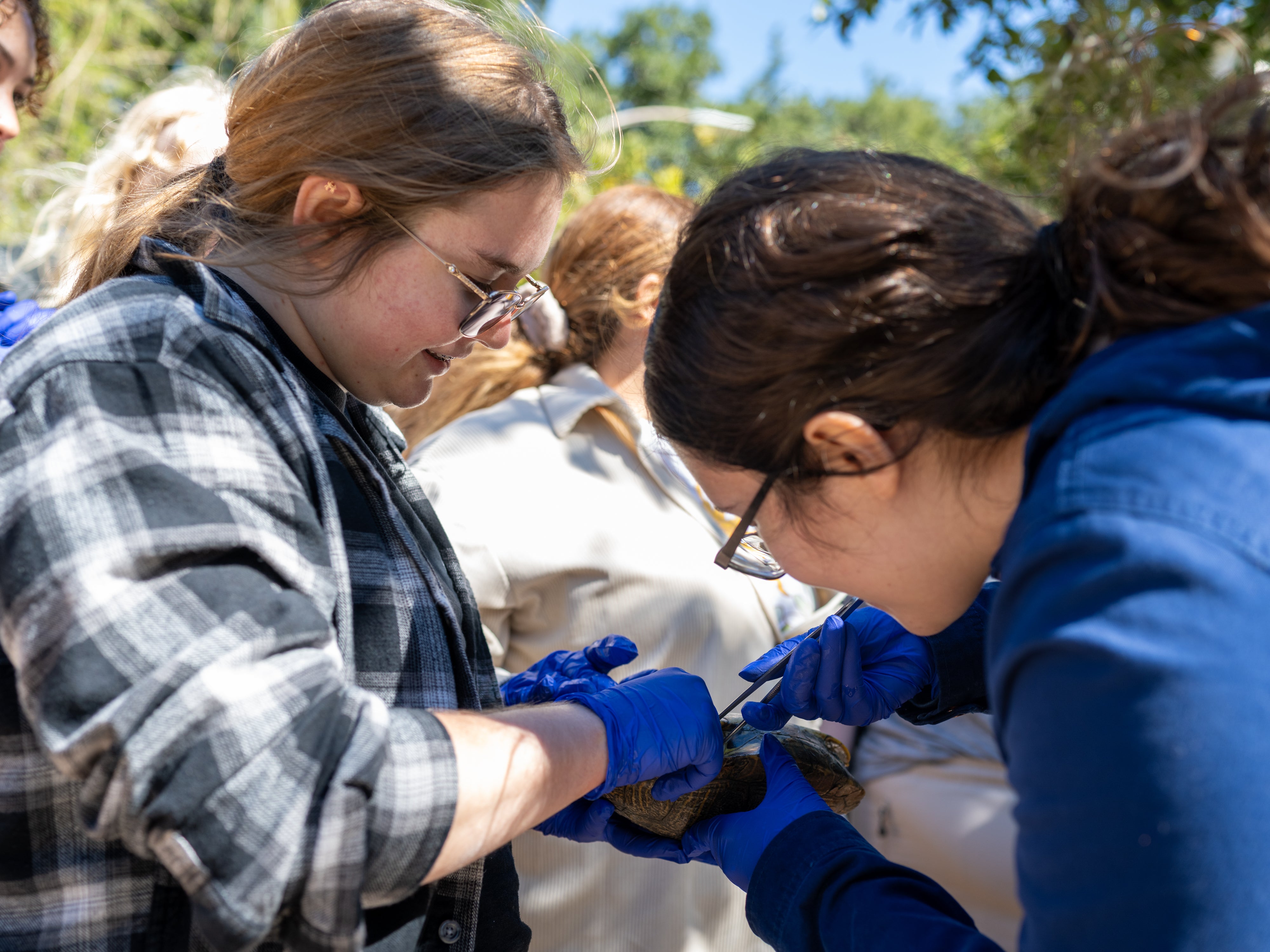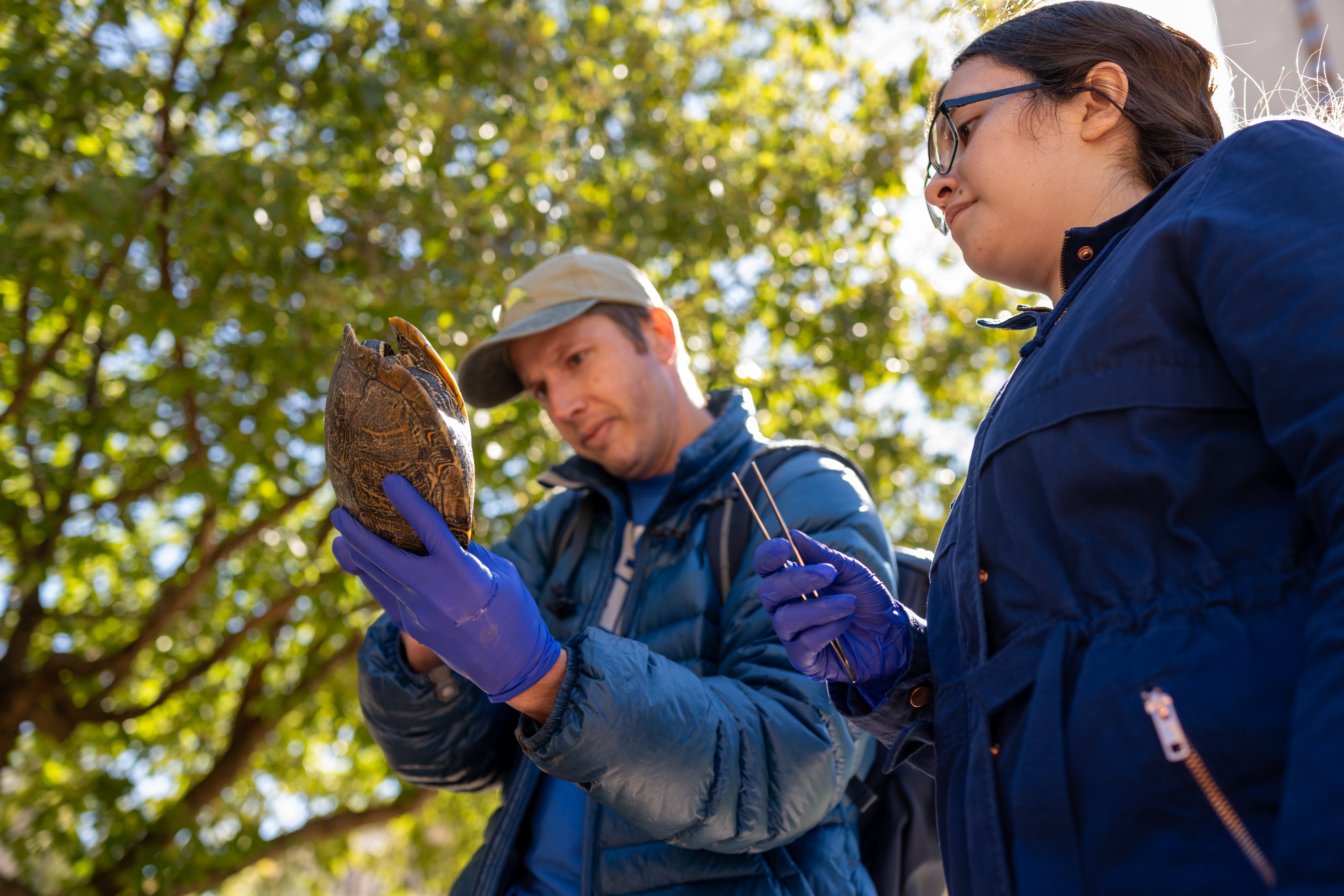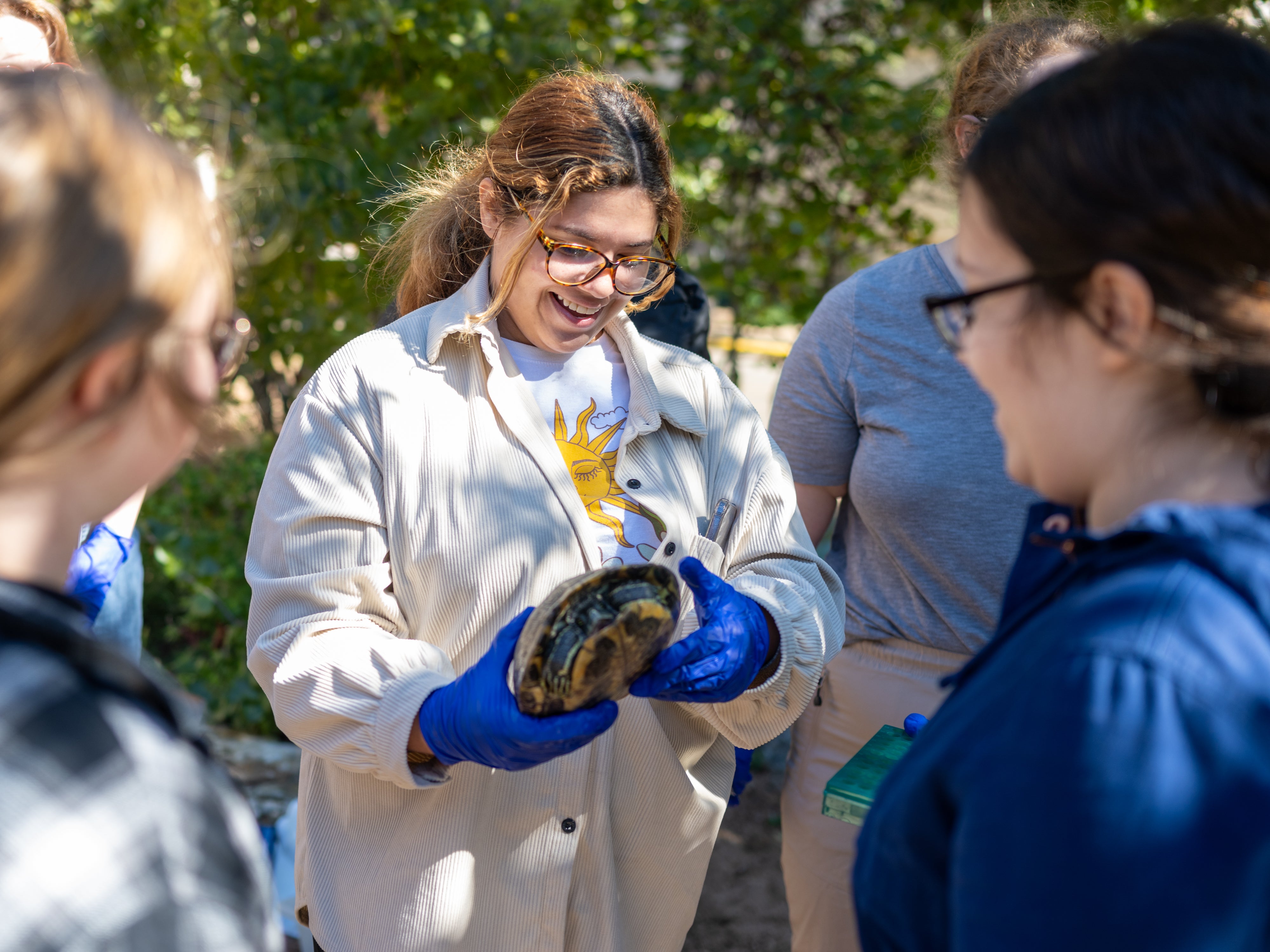Turtle Pond Offers Research Site for Undergraduates
A new long-running project allows undergraduate students to gain hands-on experience with ecological research in the heart of the UT Austin campus.

Assistant Professor Justin Havird oversees the research and helps when needed, but he said the students are the ones truly driving the project. Credit: Nolan Zunk
At the turtle pond, an on-campus oasis a minute’s walk from the UT tower, a group of undergraduates gathered in early November not just to lounge against a tree or relish in the fresh air between classes, like many students do — it was one of their first days at this aquatic research site filled with turtles, surrounded by rocks and partially shaded by trees.
This group of 15 or so students, sporting baby blue nitrile gloves on a bright yet brisk day, plucked dripping turtles from the pond to learn about their ecology and health. They tagged them and measured their height and weight.
Some students struggled to carry the squirming turtles as other students took sampling swabs. The problem wasn’t getting the turtles to open their mouths for the oral sampling, but how to get them to release the Q-tip-like swabs. “Watch for its mouth,” students repeated each time a turtle veered its neck, its beaked mouth seeking the soft flesh of a human hand.
This is the start of what student and faculty organizers hope will be a long-term series of research projects that take advantage of a historically underutilized resource right here in their academic backyard—one that offers students a chance to get experience with hands-on field research, provides scientists and administrators with insights about the health of this beloved urban ecosystem and exposes visitors to the myriad ways we impact our local environment. This research is funded by the Office of Sustainability’s Green Fund.

Several students gathered at the turtle pond in early November as one of their first sampling days. Credit: Nolan Zunk
After collecting each swab from five or so turtles that day, the students placed the samples into labeled test tubes, which they’ll use later on to analyze the turtle’s microbes — microscopic organisms which are influenced by a species’ environment, diet, behavior and more. There are estimated to be at least 100 turtles in the pond, and the goal for this study is to test samples from each of them.
“This will establish some baseline data for this population in terms of population dynamics, and in regards to their health,” said Justin Havird, an assistant professor in the Department of Integrative Biology.
Havird oversees the research and helps when needed, but he said the students are the ones truly driving the project. These students—mostly with the Ecology, Evolution and Behavior (EEB) club— proposed the project, and Havird, advisor of the EEB club, welcomed the idea. He doesn’t have experience with turtles specifically, but he is an ecologist who thinks it’s important for undergraduates to have access to such research.
“It’s a cool opportunity to do lab work that I can actually apply to real life,” said Jackie Scott, an undergraduate biology junior. Also a member of the EEB club, she sees herself continuing wildlife research going forward.

Justin Havird, advisor of the Ecology, Evolution and Behavior (EEB) club, instructed students during one of their first research days at the turtle pond. Credit: Nolan Zunk
An Ecological Check-up
Not only does this offer an opportunity for undergraduate students to delve into field research, but it can unveil some ecological components of the habitat.
As well as in the turtle pond, the researchers plan to sample turtles from other ponds mostly in the Austin area, like in Hyde Park or around Zilker Park, although they’ll be using samples from one pond in Oklahoma as well, where similar studies have been done. The researchers should be able to determine if some microbes tend to live on certain areas of an individual turtle, or which microbes might be more common in Oklahoma but less common on UT’s campus. The researchers hypothesize that there will be a unique array of microbes in the turtle pond, at least partially due to the introduction of pet turtles and processed foods, which may be harmful.
A graduate student heavily involved in the research, Mariangel Correa Orellana regularly hangs out by the pond. One turtle in particular appears to have an affinity for sun-bathing, so Orellana suspects this one could host different microbes compared with turtles sticking to the shade.
“I feel it’s really important to study the biodiversity of microbes across the pond,” said Orellana, whose area of graduate work focuses on microbial ecology. “It would also be really nice if we can teach people how to deal with the turtles in the pond.”

Mariangel Correa Orellana is a graduate student who has a leading role in this research. Credit: Nolan Zunk
Community Outreach
Orellana has seen people feeding the turtles food, like Cheetos, which is likely not in the ecosystem’s best interest. And some people seem to have introduced their pet turtles, which could also be an issue for the ecosystem, said Travis LeDuc, the university’s curator of herpetology. By studying the microbes, the researchers will understand more about the turtle population’s health, and even communicate to the public if certain activities should be avoided.
Another reason for labeling the turtles is to keep track of an individual turtle’s microbiomes and to eventually determine if new turtles are being introduced into the pond. (They likely are because the numbers are rising, yet experts say that reproduction within the existing population is limited.)
The group will be hosting community outreach events at the pond, with the first one scheduled for Tuesday, November 28, from noon to 2 p.m. These events provide an opportunity for students, citizen scientists and those simply interested in turtles to learn about this ongoing research project and about biodiversity research in Texas—not to mention, get an up-close look at these shelled stars of the Forty Acres.
The researchers plan to write an article on this study and submit it to a scientific journal, giving undergraduate students the experience of co-authoring a paper early in their careers. They also hope to present the study at a research conference.
Some biology classes take their students out to the pond and conduct research, but nothing has been entirely consistent in the 84 years of turtle pond history. That’s another exciting component of this budding project, researchers say. Even when EEB students graduate, the project will persist as new students enter, and they’ll look at other important topics in the turtle pond beyond microbes.
“We have a good feeling about the club and its longevity,” LeDuc said.



